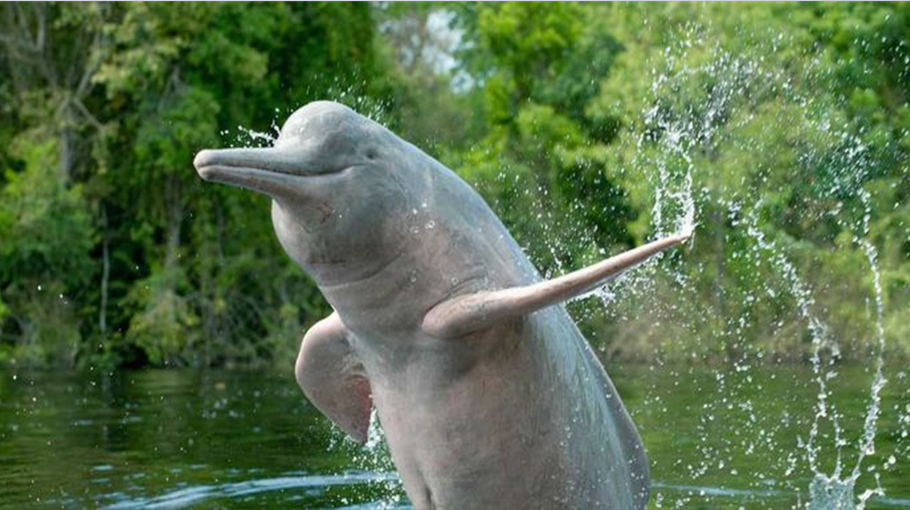Ganges dolphin on verge of extinction


The Ganges Dolphin or Shushuk (Platanista gangetica ) is one of the critically endangered aquatic animals of Bangladesh and one of the red listed mammals as mentioned by the IUCN (International Union for Conservation of Nature). It is one of the four fresh-water dolphin species left in the world with no actual number of the remaining dolphins. It is really hard to imagine that the playful Dolphins or “Susukh” that once roamed and somersaulted the river Padma by hundreds in schools of 4 to 5 in a group just off the bank, are hardly ever seen nowadays in the river.
There are also a very few books and journals and internet sites where one can find information on these animals. Loss of breeding grounds, construction of barrages over the river Ganges and drying up of the river at the downstream of Farakka, the number of Gangetic Dolphins have dwindled drastically. Nowadays, even the anglers in the river Padma could not net any Dolphin in their nets.
The Gangetic Dolphins have been a creature of amusement for the people living at the bank of the river and the passengers traveling on boats and ships for thousands of years. The fishermen used to collect fat from the Dolphin to use as medicine for the treatment of rheumatism and many other diseases. The quacks and the ‘kabiraj’ used to purchase Dolphin oil or Shusuk oil from the anglers for a handsome price.
The Gangetic Dolphins grow to a size of six feet with long toothy snout and a rubber like skin with a blowhole in the top of its head. These animals might use sound echo to travel and catch fish in the murky water of the Padma like its bottlenose cousin in the Amazon River.
There are two species of freshwater Dolphins in Bangladesh, both are on the verge of extinction or already extinct.
According to Professor Sarwar Jahan, former Chairman of the department of Environmental Science of Rajshahi University, after the construction of the Farakka Dam on the river Padma, the Gangetic Dolphins began to vanish as the water flow through the river Padma discontinued and fell drastically. As a result, the Padma at the downstream which was once enriched with biodiversity, full of biological components and fertile water for thousands of species, is now a dried sand bed with a spec of flow even during the full monsoon. Once the turbulent Padma with its grayish mineral rich water is now dried up to a desert-like riverbed with some water here and there that has now turned green.
When asked, a few of the spectators and some local fisherman in Rajshahi informed, they used to watch some of the Dolphins in the river Padma earlier but for about the last twenty years or so, they do not remember any sighting of them. The fishermen also informed that they used to catch those Dolphins for their medicinal properties. The oil derived from the fat of Dolphins is believed to cure back and leg pains and the skin of dolphins is valued for curing epilepsy though no proof of the claim is found anywhere.
On the other hand, scientists believe the meat of most dolphins are hazardous for human consumption. This was first noticed in Japan where Dolphin meat was being sold as whale meat which reportedly caused fatal consequences and hospitalizations. Still, the meat of Dolphin was a delicacy for many of the aboriginal people in Bangladesh.
No step whatsoever was ever taken anywhere to save these animals as their main breeding ground, the Padma, dried up with all of the traces of the mammals are gone. The warm water of the river Padma is ideal for breeding and raising young Susukhs and to find food. The mighty cavernous river that once terrorized the people is no longer a river now. It is now dead with its beautiful animals and fishes. It is hard to imagine, the Crocodile, Garial, Susukh, all these big predators once roamed here. If we lose the fantastic Dolphins, our next generations will never know that there were once playful dolphins just off their homes.
Researchers state that the main reason for the disappearance of dolphins is the loss of their habitat and the indiscriminate catching of those magnificent animals.
Shanil, former student of Rajshahi University and an inhabitant of Rajshahi said, decades ago when he used to visit the T-dam of Padma, he watched the roaming of playful Susuk close to him. But,”it is now impossible to find one here”, he added.




